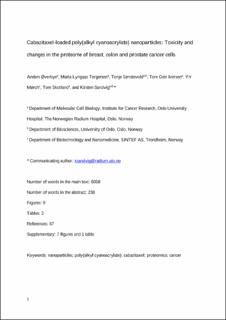| dc.contributor.author | Øverbye, Anders | |
| dc.contributor.author | Torgersen, Maria Lyngaas | |
| dc.contributor.author | Sønstevold, Tonje | |
| dc.contributor.author | Iversen, Tore Geir | |
| dc.contributor.author | Mørch, Ýrr Asbjørg | |
| dc.contributor.author | Skotland, Tore | |
| dc.contributor.author | Sandvig, Kirsten | |
| dc.date.accessioned | 2021-08-16T11:44:44Z | |
| dc.date.available | 2021-08-16T11:44:44Z | |
| dc.date.created | 2021-06-10T14:08:12Z | |
| dc.date.issued | 2021 | |
| dc.identifier.citation | Nanotoxicology. 2021, . | en_US |
| dc.identifier.issn | 1743-5390 | |
| dc.identifier.uri | https://hdl.handle.net/11250/2768011 | |
| dc.description.abstract | Nanoparticles composed of poly(alkyl cyanoacrylate) (PACA) have shown great promise due to their biodegradability and high drug loading capacity. Development of optimal PACA nanocarriers requires detailed analysis of the overall cellular impact exerted by PACA variants. We here perform a comprehensive comparison of cabazitaxel (CBZ)-loaded nanocarriers composed of three different PACA monomers, i.e. poly(n-butyl cyanoacrylate) (PBCA), poly(2-ethylbutyl cyanoacrylate) (PEBCA) and poly(octyl cyanoacrylate) (POCA). The cytotoxicity of drug-loaded and empty PACA nanoparticles were compared to that of free CBZ across a panel of nine cancer cell lines by assessing cellular metabolism, proliferation and protein synthesis. The analyses revealed that the cytotoxicity of all CBZ-loaded PACAs was similar to that of free CBZ for all cell lines tested, whereas the empty PACAs exerted much lower toxicity. To increase our understanding of the toxic effects of these treatments comprehensive MS-based proteomics were performed with HCT116, MDA-MB-231 and PC3 cells incubated with PACA-CBZ variants or free CBZ. Interestingly, PACA-CBZ specifically led to decreased levels of proteins involved in focal adhesion and stress fibers in all cell lines. Since we recently demonstrated that encapsulation of CBZ within PEBCA nanoparticles significantly improved the therapeutic effect of CBZ on a patient derived xenograft model in mice, we investigated the effects of this PACA variant more closely by immunoblotting. Interestingly, we detected several changes in the protein expression and degree of phosphorylation of SRC-pathway proteins that can be relevant for the therapeutic effects of these substances. | en_US |
| dc.language.iso | eng | en_US |
| dc.publisher | Taylor & Francis | en_US |
| dc.rights | Attribution-NonCommercial-NoDerivatives 4.0 Internasjonal | * |
| dc.rights.uri | http://creativecommons.org/licenses/by-nc-nd/4.0/deed.no | * |
| dc.title | Cabazitaxel-loaded poly(alkyl cyanoacrylate) nanoparticles: Toxicity and changes in the proteome of breast, colon and prostate cancer cells. | en_US |
| dc.type | Peer reviewed | en_US |
| dc.type | Journal article | en_US |
| dc.description.version | acceptedVersion | en_US |
| dc.rights.holder | This is an Accepted Manuscript of an article published by Taylor & Francis in Nanotoxicology on 28 May 2021, available online: https://www.tandfonline.com/doi/full/10.1080/17435390.2021.1924888. | en_US |
| dc.source.pagenumber | 20 | en_US |
| dc.source.journal | Nanotoxicology | en_US |
| dc.identifier.doi | 10.1080/17435390.2021.1924888 | |
| dc.identifier.cristin | 1915087 | |
| dc.relation.project | Norges forskningsråd: 228200 | en_US |
| dc.relation.project | Norges forskningsråd: 274574 | en_US |
| dc.relation.project | Kreftforeningen: 208239 | en_US |
| cristin.ispublished | true | |
| cristin.fulltext | postprint | |
| cristin.qualitycode | 2 | |

